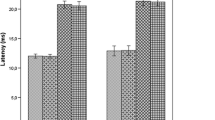Abstract
Currently, it is generally accepted that Brainstem Acoustic Evoked Potential (BAEP) may be used to diagnose functional disorders of brainstem origin. However, it is clear that the acoustic evoked potential gives proper information of the function of only a part of the brainstem. Therefore, it seems necessary to involve the examination of the functional disorder of the sensory and motor segments of the brainstem and the functional disorder of the border zone of the diencephalon having direct connection to the brainstem to the examination. The acoustic evoked potential examination of the first, 10 msec long section and the second 10 msec (10–20 msec) long section can be well used to determine the functional disorder of the latter area, as seen in case of severe, traumatic conditions of the brainstem. Severe disorders may be present in the second 10 msec long segment even if the first 10 msec long segment is intact. Lesions of the sensory and motor pathways in the brainstem lead to increased conduction time, and impaired sensory and motor functions, often on the opposite side.
You have full access to this open access chapter, Download chapter PDF
Similar content being viewed by others
Keywords
- Brainstem Origin
- Brainstem Acoustic Evoked Potentials (BAEP)
- Increased Conduction Time
- Segmental Motor
- Motor Pathways
These keywords were added by machine and not by the authors. This process is experimental and the keywords may be updated as the learning algorithm improves.
Currently, it is generally accepted that Brainstem Acoustic Evoked Potential (BAEP) may be used to diagnose functional disorders of brainstem origin. However, it is clear that the acoustic evoked potential gives proper information of the function of only a part of the brainstem. Therefore, it seems necessary to involve the examination of the functional disorder of the sensory and motor segments of the brainstem and the functional disorder of the border zone of the diencephalon having direct connection to the brainstem to the examination. The acoustic evoked potential examination of the first, 10 msec long section and the second 10 msec (10–20 msec) long section can be well used to determine the functional disorder of the latter area, as seen in case of severe, traumatic conditions of the brainstem. Severe disorders may be present in the second 10 msec long segment even if the first 10 msec long segment is intact. Lesions of the sensory and motor pathways in the brainstem lead to increased conduction time, and impaired sensory and motor functions, often on the opposite side.
Studies show that evaluation of the functional disorder of the brainstem is easier and more unequivocal when examined with multimodal evoked potential compared with the examination of only the first 10 msec of the evoked potential of the brainstem. Changes in the multimodal evoked potentials are better and more reliable methods to determine the potential changes in brainstem conditions which are often severe.
Author information
Authors and Affiliations
Editor information
Editors and Affiliations
Rights and permissions
Copyright information
© 2016 Springer International Publishing Switzerland
About this chapter
Cite this chapter
Tóth, S. (2016). Novel Consideration Regarding the Role of Evoked Potential in Confirming the Diagnosis of Eye Movement Disorders of Brainstem Origin. In: Somlai, J., Kovács, T. (eds) Neuro-Ophthalmology. Springer, Cham. https://doi.org/10.1007/978-3-319-28956-4_35
Download citation
DOI: https://doi.org/10.1007/978-3-319-28956-4_35
Published:
Publisher Name: Springer, Cham
Print ISBN: 978-3-319-28954-0
Online ISBN: 978-3-319-28956-4
eBook Packages: MedicineMedicine (R0)




